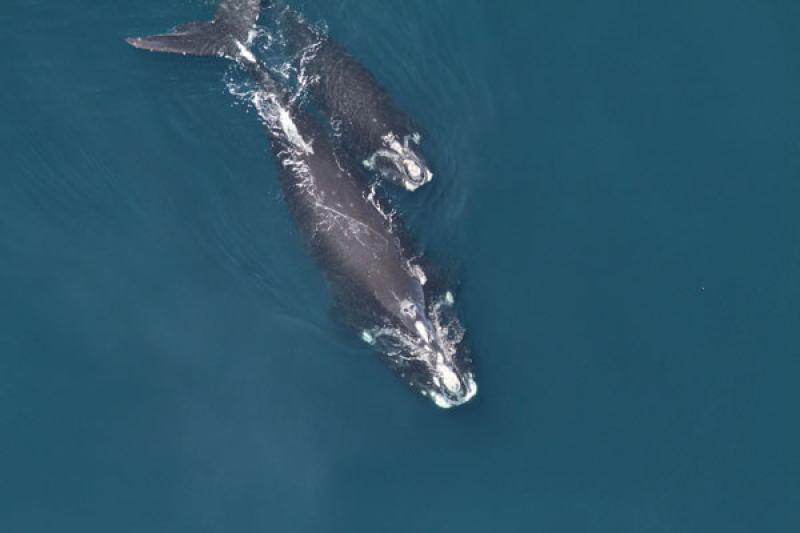NOAA’s Office of Law Enforcement has teamed up with the U.S. Coast Guard and state partners in New Jersey, Delaware, Maryland, and Virginia to conduct joint saturation patrol operations focused on the Atlantic Large Whale Take Reduction Plan.
“From November through May, there is an increased population of large whales in the mid-Atlantic waters,” said NOAA Enforcement Officer John Ford. “So, we want to make sure that fishing gear is compliant with regulations to ensure the conservation of these marine mammals and endangered species.”
Under the take reduction plan, regulations are in place to reduce the risk of serious injury and death of large whales caused by entanglement in U.S. commercial trap/pot and gillnet fishing gear. The plan is required by the Marine Mammal Protection Act and was developed by NOAA Fisheries in 1997. The plan has been updated several times, with the most recent regulations implemented in spring 2015. The current plan details where and how gear can be set, including time/area closures and gear modifications such as use of sinking ground line and weak links, number of traps, and gear markings. Other components of the plan include research on whale populations, whale behavior, and fishing gear, as well as outreach to inform and collaborate with fishermen and other stakeholders.
“The requirements for gillnets and traps/pots haven’t substantially changed recently, so fishermen are aware of what they need to have in place and we’re here to help if they have questions,” said Ford.
Regulations related to the plan’s gear requirements for trap/pot and gillnet fisheries are in effect for the mid-Atlantic region from September 1 through May 31. Some of the trap/pot requirements include:
- No buoy line floating at the surface.
- All groundlines must be made of sinking line.
- All buoys, flotation devices, and/or weights must be attached to the buoy line with a weak link having a certain breaking strength.
- Weak links must be chosen from the list of NMFS-approved gear, which includes: off-the-shelf weak links, rope of appropriate breaking strength, hog rings, and other materials or devices approved in writing. Weak links must be designed in such a way that the bitter end of the buoy line is clean and free of any knots when the weak link breaks.
Some of the gillnet requirements include regulations above as well as:
- No wet storage of gear (all gear must be hauled out of the water at least once every 30 days).
- Gillnet surface buoys must be marked to identify the vessel or fishery with one of the following: the owner’s motorboat registration number and/or U.S. vessel documentation number; the federal commercial fishing permit number; or whatever positive identification marking is required by the vessel’s homeport state.
- All gillnets that do not return to port with the vessel, regardless of the number of net panels, will be required to be anchored with the holding power of at least a 22-lb Danforth-style anchor at each end of the net string (must be a burying anchor; no dead weights).
- Fishing with drift gillnet gear at night (i.e., anytime between one-half hour before sunset and one-half hour after sunrise) is prohibited unless the gear is tended (i.e., attached to the vessel).
- All drift gillnet gear must be removed from the water and stowed on board before a vessel returns to port.
To learn more about the gear regulations included in the take reduction plan, visit the compliance guide section of the Atlantic Large Whale Take Reduction Plan website.
During the saturation patrols, enforcement personnel will be hauling gear to check weak links, gear markings, and ground lines to ensure that all gear is properly configured. Ford explained that weak links are needed to allow the gear to break free instead of getting wrapped around the whale. If gear is noncompliant, enforcement officers will contact the owner and have them pull the gear from the water until it’s compliant.
“It’s important that we are out here working with the commercial fishing community to help them with compliance and prevent any lethal interaction between whales and fishing gear,” said Ford. “We try to use a mixture of outreach, compliance assistance, and enforcement action when necessary and appropriate.”
The Atlantic Large Whale Take Reduction Team consists of fishing industry representatives, environmentalists, state and federal officials, and other interested parties. All representatives collaborated to create the plan and continue to work together to amend it to meet the goals under the Marine Mammal Protection Act. Information about the process and the team is available on the plan website.
Rules and regulations regarding mid-Atlantic trap/pot fisheries requirements and management areas may be found online.
Rules and regulations regarding mid-Atlantic gillnet fisheries requirements and management areas may be found online.
To report a violation or for compliance questions, call NOAA’s Office of Law Enforcement at 1-800-853-1964. To report an entangled whale, call 1-866-755-6622 (Maine to Virginia) or 1-877-433-8299 (North Carolina to Florida).
Story by Ally Rogers, communications officer for NOAA’s Office of Law Enforcement. To contact her, please call 301-427-8255 or emailallyson.rogers@noaa.gov.

